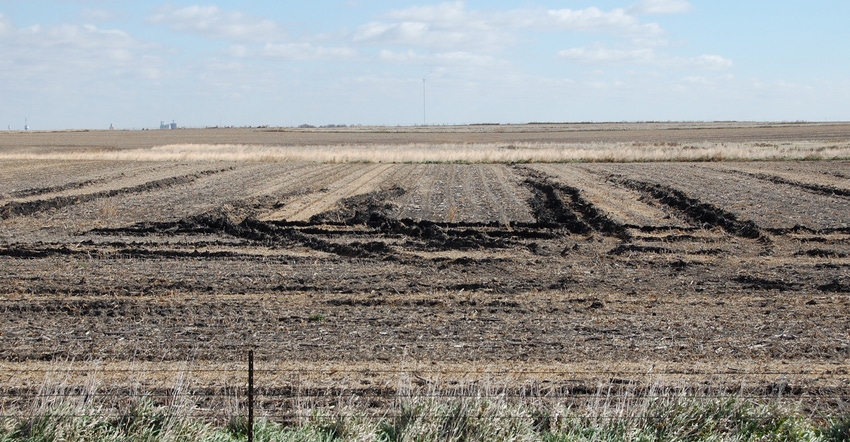January 21, 2019

Monsoon season, also known as the 2018 fall harvest season, left a lot of farmers in a tough spot. While we don’t like to run on wet soils, there weren’t many options, so folks did the best they could to get the crops out while minimizing soil damage. Unfortunately, when soils are wet like they were in many places last fall, they are more susceptible to compaction during harvest operations.
We often think about fine-textured soils (silty clay and clay) being more at risk for compaction since saturated conditions are likely to exist due to poor drainage. In a fall like 2018 though, even well-drained, medium-textured soils (loams, clay loams, silt loams and silty clay loams) are susceptible when soil moisture is at or exceeds field capacity.
Different types of compaction exist: soil surface crusting and tillage induced plow-pan. The type we may have the most concern about from last fall is, of course, the wheel-traffic type. Heavy equipment loads weaken soil structure where water works as a lubricant, leading to the collapse of soil aggregates. Essentially, we pack the soil tighter, as the traffic reduces the pore space. Soil compaction can reduce water infiltration, root development and yield for a season or more. The overall impact varies depending on soil types and condition, equipment loads, subsequent weather, and a list of other factors too lengthy for this article.
Do you have soil compaction?
How do we know if a field has compaction issues? A great question without a great answer, or at least an answer that is easily implemented by planting time. Testing the mechanical strength of soil with a tile probe, spade or penetrometer can indicate compaction, and is probably the most common and efficient way we’ll have to implement before we are ready to start fieldwork. Because effects of compaction can be subtle, taking a lot of measurements with whatever tool you pick is imperative.
Do a lot of comparisons between areas you suspect have compaction and adjacent areas that are not compacted. Good candidates are low-traffic areas like fencerows, buffer strips or adjacent fields that you don’t have compaction issues in. With wheel-traffic-type compaction, you may be able to compare traffic and non-traffic areas within your fields.
If you have ever assessed soil compaction with some of these tools, you may agree that deciding if excessive compaction does exist is part science and part experience. Probing dry soils can make you think there is compaction all over the place since they offer a lot of resistance. Probing moist soils can be tricky too since the probe or spade may go in easier. So, factor those variables in as best you can, and again, do as many comparisons as is feasible.
In-season we sometimes can see hints of compaction that can help us out if we don’t get a chance to work on it this spring before planting. Indications of soil compaction during and immediately following a normal rainfall include slow water infiltration, water ponding, high surface runoff and soil erosion.
Stunted plant growth, poor root system development and nutrient deficiencies like reduced potassium uptake can be signs of compaction, so these areas can be noted and followed up on with some root digs or soil probing. Remote imagery and sensing can be another layer of information to help identify potential problem areas.
What can we do about it this spring?
Once we have excessive compaction, especially deeper types, there aren’t really any quick fixes. Preventing compaction is what the soil scientists advocate, and that is accurate. It also is a discussion that could fill books, so we’ll stick with what to do with our current situation heading into the 2019 planting season.
The freeze-thaw cycle is a topic that comes up sometimes as a natural cure for compaction. In our part of the world, soils freeze several feet deep, more or less. But at the deeper levels, one freeze-thaw cycle per year is pretty much it.
So while over time it will help, it may not provide a quick fix for deeper compaction issues. A little better news is that the upper soil profile from the surface to 4 to 6 inches deep or so, depending on many factors, is more likely to get multiple cycles, which may help with surface compaction faster.
How about deep tillage?
Deep tillage may or may not be a viable option this spring. If conditions are dry enough to “shatter” soil between the points of a subsoiler or chisel plow, tillage can lower the bulk density of soil and reduce compaction. But you must be sure the soil at the compacted depth isn’t wet. If it is wet, then mechanical tillage will do little to loosen soil, and could make the problems worse. If it does dry out enough to give this a shot, till only to the depth needed to break up the compacted layer — no deeper, no shallower.
Picking subsoiler shanks is another art form, but with a little trial and error a lot of farmers have found the right balance of soil movement and crop residue management to fit their needs. So if you haven’t used a subsoiler in a while and wonder what shanks may work best for you, hopefully, neighbors and equipment dealers will steer you in the right direction.
Unfortunately, the way things look now regarding soil moisture, odds are our subsoils are going to be at capacity or close to it this spring. Deep tillage probably won’t have a shot at helping out.
Shallower compaction like the many surface tracks and ruts we left in fields last fall will be a case-by-case decision. Whether we just try to level up the roughest spots, so we can plant, or perhaps level the soil in any spots where full-width tillage may be considered to get a crop in the ground, the main thing will be to make sure the soil is dry enough, so we don’t create more problems on top of anything left over from last fall.
Much more could be discussed on the topic, so here are online links to some good resources for more information. Both the soil health manual and field guide offer insights relating to compaction, and the third link is for a compaction publication. They all three complement each other and are recommended reading on these cold winter days:
McGrath is the on-farm research and Extension coordinator for the Iowa Soybean Research Center at ISU. Contact him at [email protected].
About the Author(s)
You May Also Like






